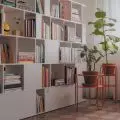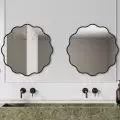Filip Robak is a graduate of the Jagiellonian University's Cultural Assets Protection Department, and is passionate about 1960s design and modernist architecture. His fascination with the restoration of old objects began at the age of thirteen and has been growing ever since. Currently Filip, together with Lech Peres, runs the Politurove furniture restoration studio in Krakow, on Topolowa Street. In the interview, he talks about his love for Nowa Huta, furniture restoration and the importance of owners' awareness of historic buildings for their preservation.
Szwedzki Blok, 1957 proj. Marta and Janusz Ingarden, os. Szklane Domy 1
Photo: Zygmunt Put © Wikipedia Commons CC BY-SA 4.0 DEED
Aleksandra Skorupa: We meet in an unusual building, the iconic Szwedzki Blok, designed by Marta and Janusz Ingarden. Have you lived here for a long time?
Filip Robak: I bought the apartment a year ago, but only recently finished the renovation. I had to throw everything out to completely clean up the space. I also restored the balcony, which had been removed by the previous owners.
Aleksandra Skorupa: And why did you choose this particular housing development? Are you originally from Nowa Huta?
Filip Robak: No, but I am from a different kind of Nowa Huta, namely Stalowa Wola, which was established a little earlier, in 1937, as the second city of the CID, a "sister" of Gdynia. Both cities have a similar steelworker vibe.
The interior of the living room in Filip Robak's apartment
Photo: Places Project by Karol Nycz
Aleksanra Skorupa: You grew up in a similar climate, a modernist apartment?
Filip Robak: Not at all. I never had to deal with any art. My parents and grandparents lived in the countryside for a very long time, in the 1980s they moved to an apartment in a large slab, and in 2008 we moved into a bungalow outside the city. In my family there was no love for old things.
Aleksandra Skorupa: So where did your love for post-war art come from?
Filip Robak: Stalowa Wola and its modernist architecture inspired me tremendously. I went on city tours organized by the local museum, met real enthusiasts of the region and started looking for interesting places and objects.
Aleksandra Skorupa: You have been professionally involved in furniture restoration for several years. What were your beginnings?
Filip Robak: In the attic at my grandparents ' house I found a pre-war Hodegetria - a wedding gift. The painting was damaged, so I took it to a restoration studio for "things of all kinds" in Stalowa Wola. There I met the owner of the studio, from whom I bought an art-deco style dressing table, covered with several layers of oil paint. The owner suggested that I come to him and, under his supervision, restore the piece of furniture. I was thirteen years old at the time. I spent a whole summer at the studio, but I did not plan to tie myself professionally to restoration. On the contrary. I thought at the time that it would have to go completely wrong in my life for me to decide on such a profession. Nonetheless, I devoted every vacation after that to buying and restoring a piece of furniture.
dresser after restoration
Photo: Project Places by Karol Nycz
Aleksandra Skorupa: And you took all the furniture home?
Filip Robak: Yes, they became the furnishings of my room. Previously I had youth furniture from the Forte Apli series, very poor quality. I cyclically threw them away and the old furniture dominated the room. My mother was initially not pleased with my passion, although she appreciated the effort put into restoring old furniture. At the moment, both parents appreciate my work very much and feel comfortable with the interiors I create.
Aleksandra Skorupa: Stalowa Wola became the place that shaped you creatively, and how did you end up in Krakow?
Filip Robak: I decided to study the protection of cultural property at the Jagiellonian University. After moving to Krakow, I rented an apartment on Szlak in a 1960s building with a long loggia. I decorated the room in a modernist climate, of course. In 2020 I bought my first apartment, on the Steel Estate in Nowa Huta, in its original condition. There I left the old parquet floors, old radiators, doorframes and terrazzo window sills. At the time, my parents still couldn't understand why I was leaving all the old elements when doing a major renovation, but the result exceeded their expectations.
Aleksandra Skorupa: When did you decide to run your own studio?
Filip Robak: At university I met Lech Peres. At first I came to his studio, restoring individual pieces of furniture, and eventually we decided to cooperate. We have been running the atelier together for several years now, and we complement each other a lot. I'm fascinated by younger furniture, from the interwar period onward, while Lech is a collector of antiques. However, I managed to convince him of design and he now owns several items from the post-war period himself.
The showcase after the renovation
Photo of Karol Nycz's Place Project
Aleksandra Skorupa: The activity of your studio is not only restoration. In what other ways do you realize yourselves?
Filip Robak: In addition to furniture restoration, we organize weekend restoration workshops for anyone who is interested. You can come to our studio with a small piece of furniture and, with our knowledge and materials, renovate it with your own hands. More and more enthusiasts of old objects come to us. This is very encouraging.
Aleksandra Skorupa: Has modernist design become fashionable? What kind of clients are coming to you?
Filip Robak: I divide clients into three groups. The first group is people from my grandparents' generation, who are restoring furniture from their youth. They care about restoring the beauty of these items. The second group is made up of younger people in their thirties to fifties, fascinated by the subject of communist-era furniture, thanks to articles, books and Facebook groups. These people consciously search for old furniture both on the Internet and in dumpsters and successively restore them. The last group of clients, the most difficult to cooperate with, are mainly young people who do not feel design, but the designer, while doing a modern interior for them, suggests that one old piece would be useful. Most often it's a chest of drawers under the TV, a dresser under the sink or an armchair. Unknowing clients want the piece of furniture to be stylized, to fit the design by force and look new. In my opinion, an object should be "given life" in its original state, emphasizing its qualities, rather than changing and harmonizing it with the whole interior. I try to explain this to my clients, but I don't always succeed and sometimes I have to adapt to their requirements. Then I try not to harm the item, so that it can be restored to its original appearance later. I like to leave "traces of time" and small imperfections on furniture.
The interior of the kitchen in the apartment of Filip Robak
Photo: Places Project by Karol Nycz
Aleksandra Skorupa: Do you still have time to rummage through trash cans yourself?
Filip Robak: Yes, I do, but the best "dumpster shots" happen when I'm running to some meeting and don't have time. I love Huta and I walk a lot. I always take the paths between neighborhoods, circle around the dumpsters and often find something. It's best to go on Sunday mornings, because on Saturday people do the cleanup. The garbage dumps then become a free antique market.
Aleksandra Skorupa:Why do people still throw away such "gems"? Are they not aware of what they own?
Filip Robak: Quite afew people, buying an apartment for huge money and doing a general renovation, don't appreciate the items that are there. They simply don't notice them. Besides, furniture in an apartment that hasn't been renovated for decades doesn't stand a chance of being well presented. Design needs the right space, background and lighting. Flippers also often clean up apartments completely, abandoning parquet floors and creating a popular, mid-quality standard with panels and MDF.
Aleksandra Skorupa: Your apartment in the previous version was an example of total architectural misunderstanding. The owners removed the parquet floors and remodeled the interiors. Why do you think this is happening?
Filip Robak: Today this is changing. Conscious people are moving to Huta now, out of choice, but until a few or a dozen years ago Huta was one of the cheaper neighborhoods, so people moved here, looking for affordable housing. The legacy of communist Poland was nothing attractive to them. The old housing, in their view, needed to be modernized. However, modern residents appreciate the architecture of Nowa Huta and the greenery that is almost everywhere here. Peculiar communities are forming around Polish design. A good example of this is Kasia Jasiolek, who started out on Facebook groups and is now the author of the excellent book "Asteroid and the Half-Cotapchan. On Polish postwar design".
The interior of a bedroom in Filip Robak's apartment
Photo: Project Places by Karol Nycz
Aleksandra Skorupa: The Szwedzki Block is such a famous building that most people who buy an apartment here probably do so consciously. But what about the indigenous residents? Are there many of them still left?
Filip Robak: There are 272 apartments in the block, divided into four types. The basic ones, like the one we're in, are about 55 meters, there are 36-meter studios in the middle, there are seven luxury apartments that are 94 meters, and there are three tiny 28-meter studios. About 20 percent of the so-called pioneers, or people who got an apartment between 1956 and 1961, live in the block. The largest group is generationally their children, or people who inherited apartments from pioneers. About thirty percent are young people, living here for five or ten years. The youngest and oldest group is unproblematic. The most difficult to communicate with are middle-aged male and female residents.
Aleksandra Skorupa: And how did you end up here?
Filip Robak: I think this is one of the most beautiful parts of Nowa Huta. The view from the window overlooking Szwedzki Park is undoubtedly one of the greatest assets of this place. Apartments in this block have always been more expensive than in others. When I was looking for a place for myself I had other assumptions. I wanted a 65-square-meter space with three rooms, but a balcony was a must. There are very few apartments with a full-length balcony in Nowa Huta, so the choice was quite limited. As soon as I walked into this apartment, I immediately saw its potential. I decided to restore it to the modernist Ingarden design and now I live here wonderfully.
Aleksandra Skorupa: Like you, I am a resident of Nowa Huta and I also appreciate the neighborhood very much. What makes it so good to live in Nowa Huta?
Filip Robak: What is very important to me is a quiet neighborhood and lots of greenery. There are few such places in Cracow. Nowa Huta has a great infrastructure, with local stores and services. I feel here like in the days of my childhood. There is a homely atmosphere and wonderful, harmonious architecture. Neighbors don't look into each other's windows. Nowa Huta is protected as a cultural park, so this order will not be disturbed. What is still missing to complete happiness is more restaurants and club cafes, open until late, which, however, are gradually being built, and their owners are noticing the architectural potential of these spaces. The best protection for a monument is a conscious owner who cares about it. The more such people, the Huta will become an increasingly beautiful place.
Aleksandra Skorupa: Thank you very much for the interview.
The interior of the bathroom in Filip Robak's apartment
Photo: Project Places by Karol Nycz










































